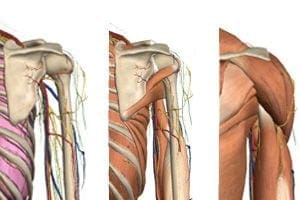statFor some women, it's about making an elegantement at special events or being a couple…

Anatomy of the Shoulder
 The shoulder is the part of the human body in which the upper arm attaches to the axial skeleton of the torso. The bones that form the pectoral girdle on each side of the body are the scapula (also known as the shoulder blade) and clavicle (collar bone) whereas the glenohumeral joint is formed by the intersection of the head of the humerus and glenoid cavity of the scapula. This coming together of the humerus and scapula is assisted by a narrow rim of cartilage known as the glenoid labrum, which slightly enlarges the glenoid cavity in order to better receive the humeral head. The clavicle and scapula articulate at the top of the shoulder at the acromioclavicular joint (so named because the acromion of the scapula meets the acromial extremity of the clavicle).
The shoulder is the part of the human body in which the upper arm attaches to the axial skeleton of the torso. The bones that form the pectoral girdle on each side of the body are the scapula (also known as the shoulder blade) and clavicle (collar bone) whereas the glenohumeral joint is formed by the intersection of the head of the humerus and glenoid cavity of the scapula. This coming together of the humerus and scapula is assisted by a narrow rim of cartilage known as the glenoid labrum, which slightly enlarges the glenoid cavity in order to better receive the humeral head. The clavicle and scapula articulate at the top of the shoulder at the acromioclavicular joint (so named because the acromion of the scapula meets the acromial extremity of the clavicle).
The shoulder joint is a ball-and-socket joint that allows the upper arm to exhibit a whole range of movement including flexion (bending up), extension (straightening out), abduction (movement away from the body), adduction (movement towards the body), lateral rotation (rotation of the arm at the joint itself) and circumduction (making circles with the arm). The shoulder joint allows a greater range of movement than any other joint in the body, and is encapsulated by a loose sac called the articular capsule that covers the area from the glenoid cavity to the neck of the upper humerus. Three sets of ligaments hold the scapula and humerus together. These are made up of the coracohumeral ligament, glenohumeral ligaments and transverse humeral ligament. Although the ligaments lend some degree of support to the shoulder joint, the majority of its strength actually comes from the associated muscles and tendons.
Muscles of the shoulder and their tendons encircle the shoulder joint and form what is known as the rotator cuff. The rotator cuff (comprised of the supraspinatus, infraspinatus, teres minor and subscapularis muscles and their tendons) joins to the articular capsule and, together with the shoulder ligaments, holds the scapula and humerus in place. Four strategically located bursae (the subscapular, subdeltoid, subacromial and subcoracoid) prevent friction between the shoulder bones as they are moved by muscular contractions.
Although part of the axial skeleton of the torso, the shoulder girdle is not physically connected to the vertebral column but held in place by a series of muscles that include the trapezius, deltoid, serratus, rhomboid, subclavius, pectoralis and latissimus dorsi.




